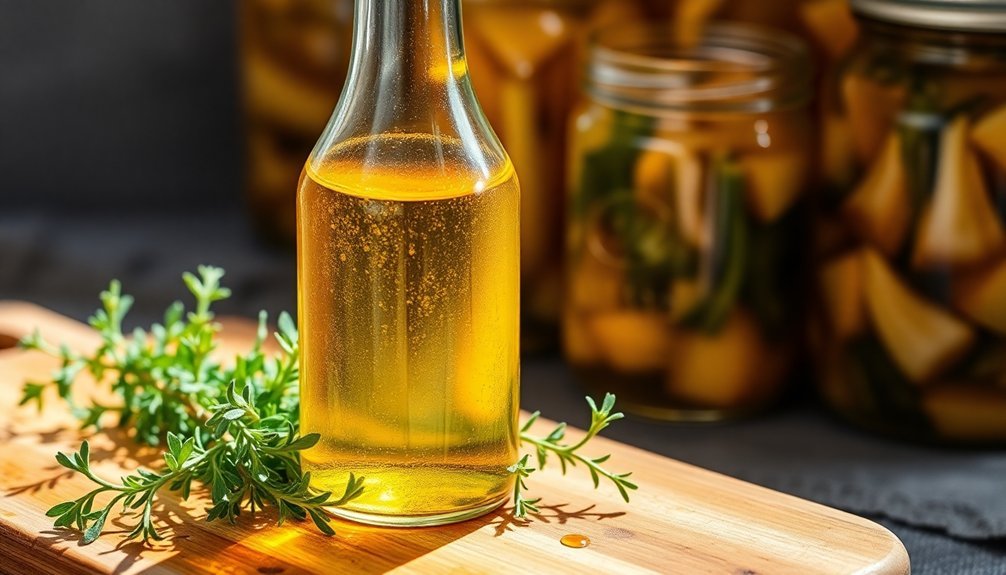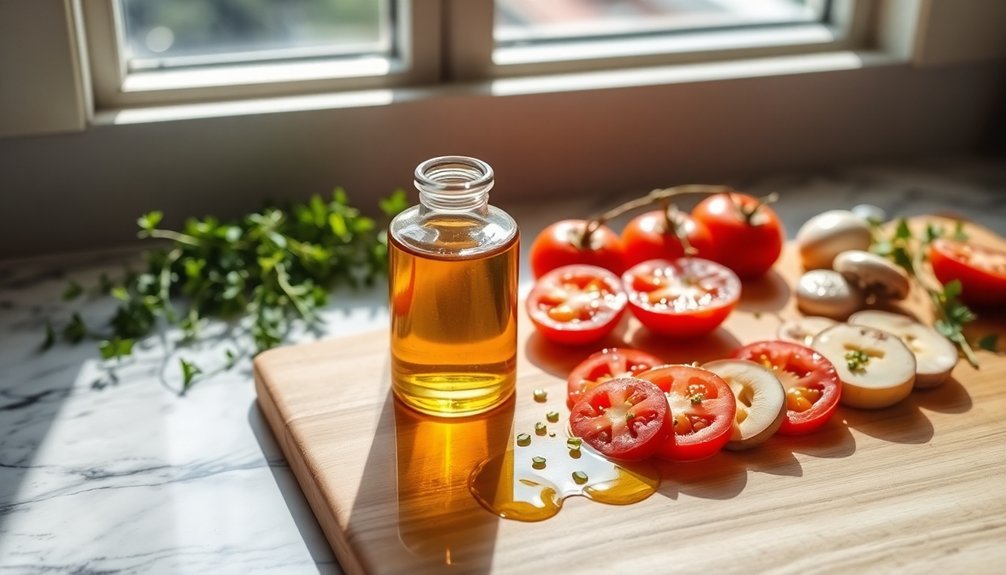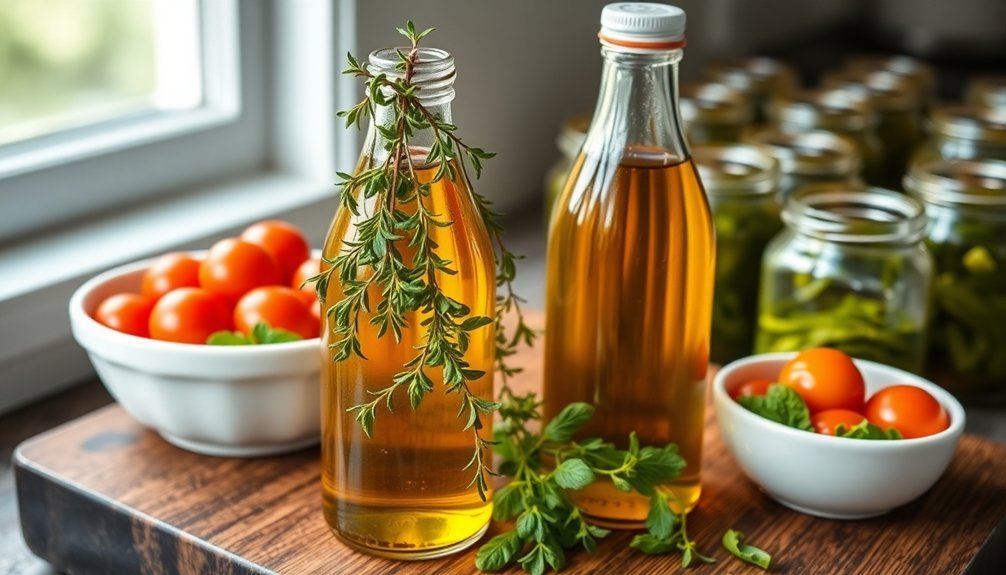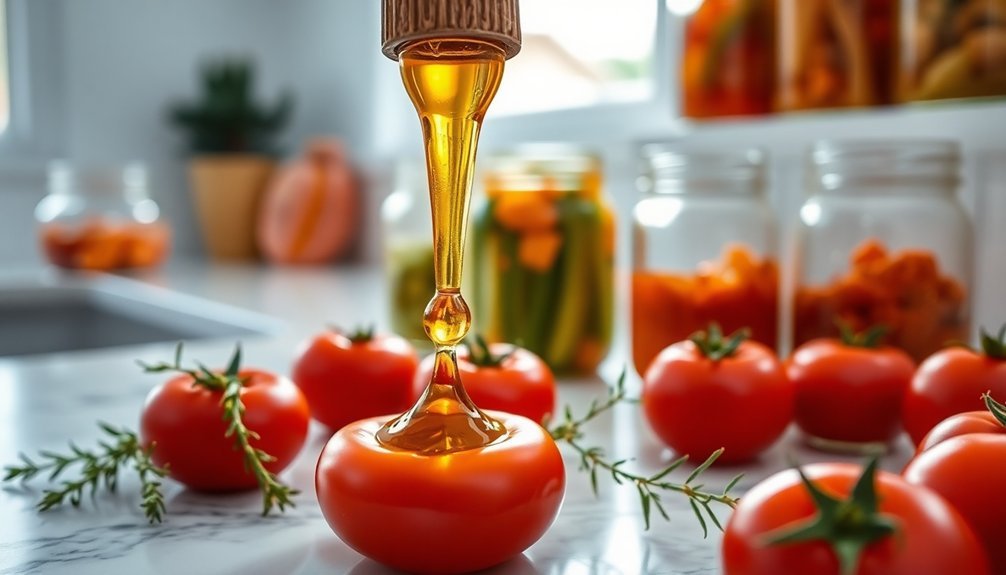You can safely preserve food using thyme oil's natural antimicrobial compounds, thymol and carvacrol. For best results, store thyme oil-treated foods at temperatures below 38°F or above 60°C, and always use clean, airtight containers with proper labeling. Apply thyme oil at a 0.5% concentration for meats, or incorporate it into edible coatings for fruits and vegetables. The oil works effectively against common bacteria like Salmonella and E. coli while preventing oxidation and spoilage. For extended preservation, try encapsulation methods using maltodextrin or chitosan. Discovering the right application method can transform your food preservation routine.
Understanding Thyme Oil Properties

The remarkable properties of thyme essential oil make it a powerful natural preservative for food. You'll find that this versatile oil primarily contains monoterpenes, including thymol, carvacrol, and p-cymene, which work together to create potent antimicrobial effects.
What makes thyme oil particularly effective is its rich composition of bioactive and volatile compounds. These components don't just work independently; they create synergistic effects that enhance the oil's overall performance. Studies indicate that edible food coatings enhanced with thyme oil provide superior preservation results.
You'll notice that the chemical makeup can vary depending on the thyme species and growing conditions, but the core beneficial properties remain consistent.
When you're looking at thyme oil's preservation capabilities, you'll discover it works through multiple mechanisms. It fights harmful bacteria like Salmonella enterica, Bacillus cereus, and Staphylococcus aureus, even at low concentrations.
You can count on its antioxidant properties to prevent lipid degradation and protect against chemical reactions that lead to food spoilage. The oil's free radical scavenging ability helps extend food shelf life, while its biofilm inhibition properties prevent bacterial colonies from forming on food surfaces.
Safe Storage Guidelines
Building on thyme oil's remarkable preservation properties, proper storage practices maximize its effectiveness and guarantee food safety. When storing foods preserved with thyme oil, you'll need to maintain temperatures at 5°C or below in your refrigerator, or above 60°C for hot storage, to prevent bacterial growth in the danger zone.
Keep your thyme oil-preserved items in clean, non-toxic containers with tight-fitting lids or proper seals. You shouldn't store these mixtures for more than 4 days in the refrigerator, but you can extend their shelf life by freezing them. During power outages, keeping freezer doors closed can maintain frozen temperatures for up to 48 hours. Don't refreeze any thawed portions, as this can lead to food poisoning. Make sure you label each container with both preparation and use-by dates.
To prevent cross-contamination, store your thyme oil preparations separately from raw foods. Place raw items at the bottom of your fridge to prevent drips onto other foods.
You'll need to monitor your stored items regularly for any signs of spoilage and always check use-by dates. When receiving new shipments, rotate your stock to use older preparations first.
Remember to keep your storage containers away from cleaning supplies and chemicals to maintain food safety.
Applications in Food Preservation

Modern food preservation relies heavily on thyme oil's versatile antimicrobial and antioxidant properties. You'll find this natural preservative particularly effective in meat products, where a 0.5% concentration helps reduce radical formation and prevent spoilage. The oil's powerful compounds like thymol and carvacrol have proven highly effective in food safety applications.
When you combine it with other essential oils like clove oil, you'll achieve even better preservation results.
For fresh-cut fruits, you can use thyme oil in alginate-based edible coatings. A concentration of 0.5 µL mL^-1 works effectively, especially for apples, reducing respiration rates, weight loss, and browning.
You'll notice it outperforms other essential oils like cinnamon and oregano in maintaining fruit firmness and nutritional value.
In seafood preservation, you can apply thyme oil to protect against both microorganisms and chemical reactions. It's an excellent alternative to synthetic preservatives, and you'll find it particularly useful in extending shelf life while maintaining product quality.
When implementing thyme oil in your food preservation techniques, remember that its effectiveness varies depending on the food matrix and target microorganisms.
You'll need to take into account the minimum inhibitory concentration specific to your application and potential interactions with other food components.
Encapsulation Methods and Benefits
To maximize thyme oil's effectiveness in food preservation, you'll want to evaluate various encapsulation methods that protect and stabilize its active compounds. Three main techniques stand out: spray drying with maltodextrin, complex coacervation, and chitosan nanoparticles. Each method offers unique advantages in preserving thyme oil's antimicrobial properties and extending its shelf life.
- Spray drying achieves an impressive 87.16% encapsulation efficiency using maltodextrin as a protective wall material, with ideal processing at 110°C inlet and 70°C outlet temperatures.
- Complex coacervation creates a protective micro-environment that maintains lower MIC values compared to free oil.
- Chitosan nanoparticles deliver a concentrated dose of 1.67 mg/mL essential oil while providing enhanced antibacterial activity.
- All methods greatly extend shelf life to at least 30 days without synthetic preservatives.
You'll find that encapsulation enhances thyme oil's stability through improved retention of key compounds like carvacrol. The process also maintains antimicrobial efficacy against bacteria and molds, making these solutions ideal for food preservation applications.
Whether you choose spray drying, complex coacervation, or chitosan nanoparticles, you're ensuring better protection against volatilization and consistent release of the essential oil's active components.
Extending Fresh Food Life

Preservation success depends heavily on thyme oil's dual-action approach to extending fresh food life. You'll find its antimicrobial properties effectively combat harmful bacteria like Listeria, Salmonella, and E. coli, while its antioxidant capabilities prevent food degradation. When you're looking to preserve fresh-cut fruits, meats, or seafood, thyme oil delivers impressive results.
| Food Type | Preservation Method | Benefits |
|---|---|---|
| Fresh-cut Fruits | Alginate-based coating with thyme oil | Reduces browning, inhibits microbial growth, maintains firmness |
| Meats | Vacuum packing with thyme oil | Prevents lipid oxidation, reduces spoilage, masks unpleasant odors |
| Seafood | Direct application | Protects against microorganisms, slows chemical reactions |
You'll get even better results when you combine thyme oil with other preservation techniques. For instance, using it with modified atmosphere packaging can considerably extend lamb meat's shelf life. If you're preserving minced meat products, thyme oil reduces both microbial growth and rancidity indicators. For ideal results, consider combining it with oregano oil, as this pairing enhances antimicrobial effectiveness. The oil's versatility extends to baked goods too, where it can replace synthetic preservatives in items like cakes.
Best Practices and Safety Measures
Your success with thyme oil preservation depends on following proper storage guidelines, including keeping your preserved items in a clean, cool, dark space between 50-70°F.
When applying thyme oil, you'll need to use clean equipment and maintain strict hand hygiene to prevent bacterial contamination.
You must also avoid cross-contamination by using separate utensils and surfaces for raw meats and ready-to-eat foods, while properly labeling and dating all preserved items.
Proper Storage Guidelines
Three critical storage guidelines determine the safety of herbs and vegetables preserved in oil. When storing raw or cooked herbs, you'll need to keep them refrigerated at temperatures below 38°F to prevent botulism.
Don't store these mixtures for more than three weeks, even in the refrigerator. If you're using dried herbs and vegetables, you can safely store them at room temperature since they lack the moisture necessary for bacterial growth.
To maximize the safety and effectiveness of your thyme oil preparations, follow these essential guidelines:
- Remove any flavoring solids from oil immediately after infusion if you plan to store at room temperature.
- Always use completely dried ingredients when creating herb-oil mixtures for room temperature storage.
- Consider combining thyme oil with other preservation methods like refrigeration for enhanced safety.
- If you're using commercial products, check that they're properly acidified for room temperature storage.
When working with thyme oil's antimicrobial properties, you can incorporate it into edible coatings or use it in encapsulated form to extend shelf life.
Remember that proper storage temperature is your first line of defense against bacterial growth, particularly the dangerous C. botulinum.
Safe Application Methods
When applying thyme oil safely, proper handling techniques and safety measures play an essential role in preserving food effectively. You'll need to start with fresh, high-quality thyme and extra virgin olive oil to guarantee maximum antimicrobial benefits. Remove the herbs from stalks and chop them into manageable pieces before combining with oil.
| Application Method | Safety Consideration |
|---|---|
| Ice Cube Method | Fill trays halfway with herbs, cover completely with oil |
| Direct Application | Guarantee even distribution, avoid over-concentration |
| Storage Preparation | Use airtight containers, maintain oil coverage |
For the best preservation results, you'll want to guarantee the herbs are completely submerged in oil to prevent oxidation and bacterial growth. Don't overfill containers with herbs, as this can prevent proper oil coverage. You can enhance the preservative effects by combining thyme oil with other natural preservatives like alginate. When applying to meats or fresh-cut fruits, distribute the mixture evenly to maximize its antimicrobial properties against harmful bacteria like Listeria and Salmonella. Remember to label your containers with preparation and use-by dates, and always store prepared mixtures in airtight, freezer-safe containers.
Avoid Cross-Contamination Risks
To prevent cross-contamination while using thyme oil as a food preservative, following strict handling protocols becomes essential.
You'll need to maintain separate utensils and equipment specifically for thyme oil application, just as you'd separate tools for raw and cooked foods. Store your thyme oil solutions away from other ingredients, chemicals, and cleaning supplies to avoid any contamination risks.
- Keep your thyme oil preparation station clean and sanitized, using food-safe cleaning products that won't leave harmful residues that could mix with the oil.
- Use dedicated containers for your thyme oil solutions, and don't repurpose chemical containers even if they're thoroughly cleaned.
- Store thyme oil-treated foods in properly covered containers at least six inches off the floor and away from walls to prevent environmental contamination.
- When applying thyme oil to different food items, use separate application tools for each to prevent cross-contact between foods.
Remember to wash your hands thoroughly before and after handling thyme oil preparations, and consider using disposable gloves during application.
Clean and sanitize all food-contact surfaces between different batches of thyme oil-treated foods to maintain safety standards and preserve the oil's effectiveness.
Frequently Asked Questions
Can Thyme Oil Eliminate Foodborne Pathogens That Have Already Contaminated Food?
Yes, you'll find thyme oil effectively eliminates many foodborne pathogens in contaminated food. It can reduce Salmonella and Campylobacter by 3.6 log cfu/mL, while also destroying E. coli and Staphylococcus aureus.
How Does Thyme Oil Interact With Different Packaging Materials?
You'll find thyme oil increases film transparency and water resistance when added to biodegradable packaging. It enhances tensile strength and flexibility in PLA/PBAT films, while also improving barrier properties in alginate-based coatings.
Is Thyme Oil Effectiveness Reduced When Combined With Certain Spices?
Yes, you'll find that thyme oil's effectiveness can be reduced when mixed with certain spices. While it works well alone, specific combinations may create antagonistic effects that diminish its antimicrobial and antioxidant properties.
What Temperature Changes Can Encapsulated Thyme Oil Withstand Before Losing Potency?
You'll find encapsulated thyme oil maintains its potency up to 318°C, while free thyme oil degrades at 170°C. It's stable during storage at both 4°C and 40°C without significant loss of effectiveness.
Does Thyme Oil's Antimicrobial Activity Vary Between Different Food Ph Levels?
You'll find thyme oil maintains consistent antimicrobial activity across different pH levels. While nanoemulsion stability can vary with pH, its effectiveness against bacteria remains strong, especially in meat preservation applications.
In Summary
You'll find thyme oil solutions offer a reliable natural preservative for extending food shelf life. By following proper encapsulation methods and storage guidelines, you're able to safely harness its antimicrobial properties. Remember to maintain recommended concentrations and combine with appropriate food safety practices. Whether you're preserving fresh produce or prepared foods, thyme oil provides an effective, natural alternative to synthetic preservatives.





Leave a Reply